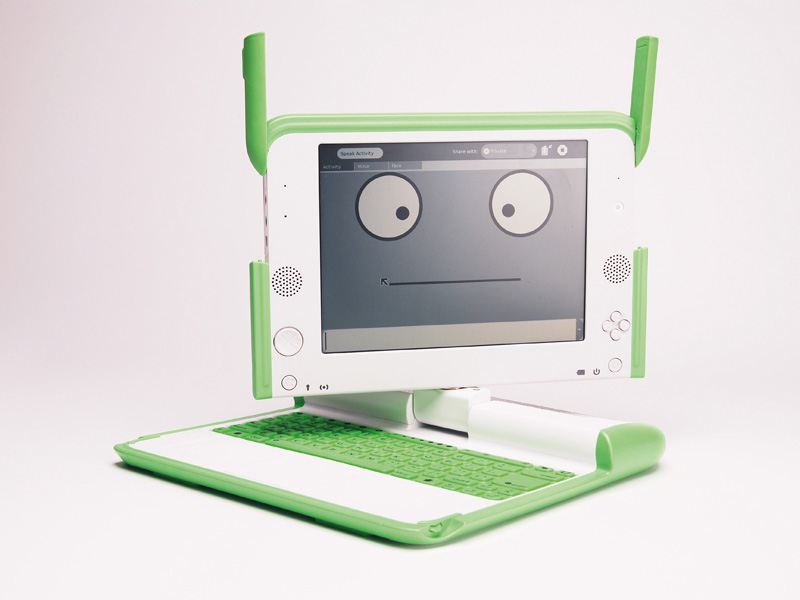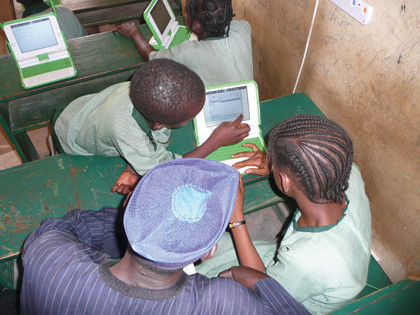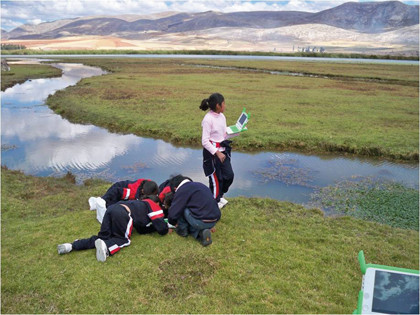
Education can be so easily taken for granted, especially when you consider that every child in the UK has access to a computer, whether it's at home, at school or in libraries.
But what most people forget is that one billion children in the developing world have little access to education and no access to computers, which is where a burgeoning non-profit organisation called One Laptop Per Child (OLPC) comes in.
The organisation hit the headlines in 2007 when it developed a low-cost laptop called the XO, which was designed to be bought cheaply by governments of developing countries and distributed among school children.
The XO was originally dubbed 'the $100 laptop', and although three years on it still hasn't achieved its target price, it has been purchased by the governments of 21 developing countries and distributed to 1,284,500 children across the world.
However, while the organisation has helped many children, it has also courted controversy and created rifts with the world's biggest technology companies.
One Laptop Per Child was the realisation of an altruistic dream by MIT director and professor Nicholas Negroponte. In 2005, he unveiled his plan to see a laptop given to every child in the developing world.
The idea was based on the creation of something completely unique: a laptop durable enough to withstand the stresses and strains of life in a developing country, cope with the very real challenges of an intermittent power supply and internet availability, and cost just $100.
Get daily insight, inspiration and deals in your inbox
Sign up for breaking news, reviews, opinion, top tech deals, and more.

The design of the XO PC was outstanding, and should be regarded as a great feat of computer engineering.
Against the backdrop of the prices of technology in 2005, which was before low-cost and low-power components were prevalent, Negroponte designed a laptop with a 433MHz processor, 256MB RAM and a 7.5in LCD display and wireless networking for only $199.
This price was completely unheard of at the time, and the device had enough power to drive Sugar, its bespoke Linux operating system. It could function as a laptop and ebook reader, had a screen that was clearly visible outside in direct sunlight, had 12 hours of battery life and was completely shockproof, waterproof and dustproof.
While the XO preceded the market in terms of design, its biggest challenges were to overcome the rigours of a life in the hands of children in developing countries. Availability and reliance on power was a problem for Negroponte, and the XO could not succeed if it was too power-hungry.
OLPC also had to iron out the biggest failing point of consumer laptops: hard disk crashes. The XO introduced flash drives, which eliminated the mechanical wear and tear of traditional spinning disc drives.
What's more, the XO featured a revolutionary new screen that used a dynamic LED backlight, which reduced operating wattage down to 3W under normal conditions. This put battery life at 12 hours, far beyond that of normal consumer laptops, and made the XO a force to be reckoned with.
A new kind of PC
The XO laptop caused such a stir that it's credited with spearheading the netbook craze, which is still the only PC submarket that's actually growing. Once OLPC had mastered the low-power components, screen and size, it started selling the devices in the US.
The laptop was retailed as part of the Give One Get One campaign, where a US consumer purchased a laptop for $400, and donated one to a child in a developing country at the same time. It's this campagin that Wayan Vota, Editor of independent community OLPC News, believes caught the eye of companies such as Asus and Acer.
"The real threat of OLPC introducing a '$100 laptop' was enough to spur technology companies into action. And they had to act fast. OLPC sold 160,000 XO laptops at $400 for two – and you didn't even get both. That had Asus rightly excited when it launched the EeePC line to amazing success," he said.
Once Asus made a commercial success of its Eee PC, the whole market had to catch up – and within six months every laptop manufacturer was shipping a netbook.
In 2009, there were 33.3 million netbooks sold globally, and the sector achieved a 72 per cent growth in sales, while there was a 13 per cent decline in the amount of notebooks sold. If its supporters are correct, One Laptop Per Child caused one of the biggest technology sensations of the decade.
"The creation of the netbook market is largely, and appropriately, credited to OLPC," says Ed McNierney, Chief Technical Officer of OLPC. "We wouldn't have $300 netbooks in the consumer market if that push from OLPC hadn't happened.

"Consumer product companies in the technology world are not known, in general, for their risk-taking behaviour," he told PC Plus.
However, when asked for a comment, an Asus spokesman told PC Plus that the XO had no bearing or effect on the creation of the EeePC 701, and that the company would have come to market with a similar product even if the XO hadn't been invented.
Competition
It's not often that a non-profit organisation courts competition and controversy, but the technology industry can be an unpredictable world, and it wasn't long before OLPC found itself embroiled in a war of words with Intel.
The world's biggest chipmaker had seen the market potential of the developing world and built its own low-cost laptop, the Classmate PC, soon after the announcement of the OLPC XO – a move that incensed Negroponte.
He called Intel "predatory" in a lecture at MIT and accused the company of "hurting the [OLPC] mission" on the CBS news show 60 Minutes in 2007. If this wasn't enough, Negroponte then accused Intel of selling its Classmate PC to the same governments he was trying to persuade to take up orders of the XO at a loss-making sum, scuppering his project.
In the face of widespread criticism, Intel eventually joined forces with OLPC in December 2007. This uneasy alliance caused public consternation from AMD, a founding partner of the OLPC project.
While the Intel/OLPC partnership promised a new beginning, the reality was very different. Less than six months later, Negroponte dropped Intel representatives from OLPC's board of directors, demanding that Intel dump its Classmate project if the two companies were to continue to work together.
With the money Intel has invested in its own project, it was never going to can the Classmate PC, so the relationship came to an end.
Since 2007, both laptops have seen their share of success and failure, with Intel shipping one million Classmate PCs to Venezuela and 150,000 to Libya.
OLPC, meanwhile, has saturated Uruguay and Peru with approximately one million XO laptops and also completed smaller orders from Colombia, Rwanda and Mexico.
Whether Intel's Classmate PC project hurt the OLPC effort or not is still the subject of intense debate, but Vota doesn't think that was the case. He believes that the enthusiasm created by both the XO and the Classmate PC made Negroponte's dream a reality.
"I've heard from Intel insiders that the XO laptop moved the netbook revolution forward by a few years," he told PC Plus.
"Intel would've come out with a Classmate-like device, but not as soon as they had to with OLPC's pressure. For this, both organisations should be thankful because netbooks are the only bright spot in the laptop business."
However, the bright spot of technology might not look so good for OLPC. It's not been able to get its unit cost down to the desired $100, and orders have been far from overwhelming.
What's more, the consumer market has caught up, and it's possible to buy standard netbooks that cost as little as an XO. While they're not built quite as ruggedly, they do feature fully functional operating systems such as Windows, which some say would better prepare children for a connected future.